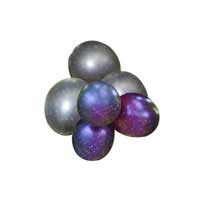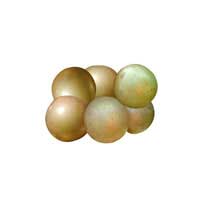 Full List of Fruits
Full List of Fruits  Muscadine Fruit
Muscadine FruitMuscadine Fruit
![]() Introduction of Muscadine Fruit
Introduction of Muscadine Fruit
Scientific name - Vitis rotundifolia
Vitis rotundifolia commonly known as Muscadine is a grapevine species tha'’s indigenous to the South of North America. Extensively cultivated since the 16th century, it has a widespread recognition for its natural range in almost all states of the US. It thrives in summer heat and is well-adapted to their native humid type of weather. With fewer chilling hours, they are said to grow even better compared to other known varieties.
Features of Muscadine are just like grapes and these berries are bronze to dark purple in color and become black when ripe. On the other hand, a lot of wild varieties stay green through ripeness. Apart from being consumed fresh they are also used in making jelly, wine and marmalades.
Quite different from the large, tight bunches, characteristic of European and American grapes, Muscadine berries are borne in small, loose clusters of 3-40 grapes approximately. With just about five oblong and hard seeds, they have a tough skin and are round, thick, 1 to 1-1/2 inch in size. As far as color of the fruit is concerned, they range from greenish bronze to bronze, pinkish, purple, red and black. They are sweet to taste and it varies from about 16% to 25% for the sweetest cultivars. Wild fruits have a musky quality and this is with regards to older cultivars, with modern cultivars, they are said to have a unique flavor that's fruity, but with less muskiness. It is compared remarkably to the jaboticaba because of the flavor and appearance.
![]() Nutritional Value of Muscadine Fruit
Nutritional Value of Muscadine Fruit
| Nutrient | Bronze-skinned | Dark-skinned |
| Calories | 68 | 76 |
| Protein | 0.5g | 0.5g |
| Fat | 0.4g | 0.4g |
| Carbohydrates | 12g | 14g |
| Sodium | 5mg | 7mg |
| Calcium | 17mg | 24mg |
| Potassium | 163mg | 167mg |
| Magnesium | 5mg | 5mg |
| Vitamin C | 7mg | 6mg |
| Dietary Fiber | 3g | 3g |
| Soluble Fiber | 1g | 1g |
![]() Health Benefits of Muscadine Fruit
Health Benefits of Muscadine Fruit
It is always worth seeking out Muscadine because they are highly nutritious than the average table grape. They are a major source of phytonutrients; following are some of the health benefits that you can enjoy consuming Muscadine and it includes:
 Maintains bowel regularity
Maintains bowel regularity
 Controls blood glucose concentrations
Controls blood glucose concentrations
 Helps in reduction of oxidative stress to heart and blood health
Helps in reduction of oxidative stress to heart and blood health
 Reduction of inflammation to blood vessels to reduce atherosclerotic plaque formation
Reduction of inflammation to blood vessels to reduce atherosclerotic plaque formation
In 3-5 years time, crops can be expected; commercial yields of 20–45 tonnes per hectare (8–18 tons per acre) are possible. It prefers sandy loam and alluvial soils to flourish. They take roots and grow wild in well-drained bottom lands that are not subject to extended water supply deficiency or water logging. Furthermore, they are dead set against to certain type of pests and diseases together with pierce disease, which can annihilate other grape species. This variety is one of the grape species that’s resistant to Phylloxera, an insect that can exterminate roots of grapevines.
To propagate muscadine fruit, the first step is to select the parent vines from which to take the cuttings. The parent vines should be healthy, disease-free, and at least one year old. Cuttings should be taken from the current year's growth and should be about 6-8 inches long. The cuttings should be taken from the middle part of the vine and not from the tips.
Once the cuttings have been taken, they should be placed in a container of water and stored at room temperature for a few days. This allows the cuttings to develop calluses, which will help them take root.
The next step is to prepare the soil in which the cuttings will be planted. Muscadine vines should be planted in soil that is well-draining, with a pH between 5.5 and 6.5. Before planting, the soil should be amended with organic matter such as compost or manure.
When the soil is ready, the cuttings should be planted at least 1 foot deep. Plant several cuttings in each hole, and make sure that the cuttings are spaced at least 4-6 feet apart. After planting, the soil should be well-watered and mulched with straw or wood chips.
The newly planted cuttings should be monitored closely for signs of disease or insect damage. If any problems arise, they should be treated as soon as possible. The cuttings should also be pruned regularly to encourage new growth.
Once the cuttings have taken root and have begun to produce new growth, they should be fertilized with a balanced fertilizer. The fertilizer should be applied every three months during the growing season.
With proper care and attention, muscadine fruit can be successfully propagated. The cuttings should produce a crop of fruit within two years. Muscadine fruit can be an excellent addition to any garden or orchard, providing a tasty treat for years to come.


















